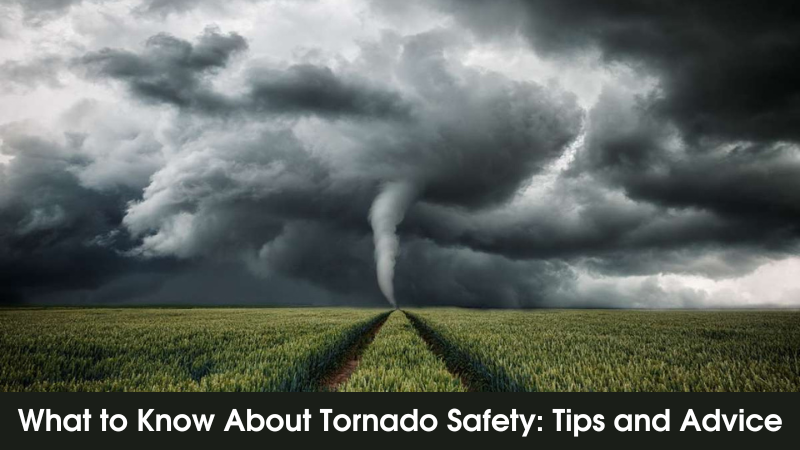Staying Safe During Tornado, Hurricane, Storm: Tips and Advice

The Federal Emergency Management Agency (FEMA) has distributed universal recommendations for citizens in case of a hurricane, storm or tornado. Please read carefully and share! It might save someone’s life.
If a hurricane finds you in a building, move away from windows and take a safe place against interior walls, closets, hallways, bathrooms, pantries, closets, sturdy cabinets, under tables. Put out the fire in the stoves, turn off the electricity, close the taps on the gas networks.
At night, use lamps, lanterns, candles; turn on the radio to receive information from the Federal Emergency Management Agency (FEMA), if possible, stay in a deep shelter, in shelters, cellars, and so on. If a storm, hurricane or tornado caught you on the streets of a settlement, stay as far away as possible from light buildings, bridges, buildings, overpasses, power transmission masts.
Try to quickly take cover in basements, cellars and anti-radiation shelters that are in settlements. Do not enter damaged buildings, as they can collapse with new gusts of wind. During a snowstorm, take cover in buildings.
What should NOT be done during a tornado, storm or hurricane?
During a storm, tornado or hurricane, you should NOT:
- Use gas stoves or any electrical appliances in the house.
- Go inside dilapidated, damaged buildings.
- Take shelter from the wind behind billboards, trees, fences and dilapidated buildings.
- Be near masts and poles, as well as objects with flammable and poisonous substances.
- Touch the pipes of gas supply, water supply, central heating, as well as broken wires of power lines.
- Stay on bridges, high places, and near power lines and pipelines.
What to do after a tornado, storm or hurricane
- Beware of fallen trees, as well as swinging banners, signs, billboards, shutters.
- Be careful when walking around broken power lines, as they may be live.
- Beware of gas leaks in homes, disruptions in the electrical network.
- Use of any electrical appliances is allowed only after they have been checked and thoroughly dried.
- In cases where a storm is accompanied by a thunderstorm, beware of electric shock (lightning).
What to do if there is a tornado warning?
First of all, listen carefully to the instructions of the Federal Emergency Management Agency headquarters. They will report the estimated time and strength of the hurricane, recommendations for the use of shelters and evacuation. Then you need to take personal measures of self-defense:
- tightly close windows, doors, attic hatches and ventilation openings; paste over window glass, if possible protect it with shutters or shields;
- prepare an autonomous supply of water and food, medicines; take a flashlight, a kerosene lamp, a candle, a camp stove or a kerosene stove, a battery-operated receiver; take documents and money with you;
- remove from balconies, window sills and loggias things that can be captured by the air flow; the same applies to objects in the yard or on the roof;
- put out the fire in the stoves, prepare to turn off the power grid, close the gas valves;
- leave radios and TVs on: they may receive new important information;
- move from light buildings to more durable or GO shelters.
Children from kindergartens and schools must go home, all events are cancelled; if the storm warning comes too late, the children are housed in the basement or central part of the buildings.
It is best to wait out a hurricane in a shelter, a pre-prepared shelter, or at least in the basement. If this fails and you have to meet the onset of a natural disaster in a building, you need to choose the safest place – in the middle of the house, in the corridors, on the ground floor. Shards of flying windows can hurt, so you should stand in the wall, close to the wall, hide in a built-in closet or protect yourself with mattresses.
How dangerous a hurricane is can be judged in advance if its strength is known. Hurricane, storm, storm – in general, all these are names for the same wind. But the biggest difference between them is speed.
If you find yourself on the street during a hurricane or storm, you need to be as far away from buildings as possible and hide in a ditch, pit, ditch, clinging tightly to the ground. This will save you from flying fragments of tiles, slate, glass, various objects, torn off road signs and bricks – the most likely sources of danger. Of course, if there is an opportunity to be in the shelter or the basement of the nearest building, then you need to do it as quickly as possible.
Large structures – bridges, overpasses, pipelines – must be avoided at all costs. You must bear in mind that man-made disasters and fires are a common result of severe natural disasters, so it is better to stay away from chemical and oil refineries, various high-risk facilities and power lines. By the way, a defeat by atmospheric electricity is also possible, since a thunderstorm often comes along with a storm.
When the wind has calmed down, you should not go outside immediately: the squall may repeat in a few minutes. Then, when it becomes clear that the hurricane has ended, leave the house carefully. First, look around – check if there are any hanging objects and parts of the structure, broken wires, or a smell of gas. The fire should not be lit until there is confidence that there were no leaks. You can’t use elevators either.
One type of natural disaster is a snowstorm. It can last for several days, but even in a few hours a snowstorm can seriously disrupt the life of the city. At this time, you can leave the house only in exceptional cases and never alone. Let your neighbors know where you’re going and when you’ll be back.
The car can only move on major roads and highways. If you lose your bearings and want to look around, you can not move away from the car out of sight. In general, it is better to wait out a snow storm in the nearest settlement.
Hurricane, storm, tornado: advice from rescuers
Only by preparing in advance can you prevent colossal damage from the raging elements. Below, we will talk about how rescuers advise to behave during the onset of a storm, tornado or hurricane.
So, if you notice that a storm, a hurricane or a tornado is coming, you need to find shelter as soon as possible: a metro station, a basement, an underpass, a foundation pit of a building under construction.
If you are in an open area where there are no buildings, railway embankments, roadside ditches, beams, hollows and ditches can come to your aid. Find any recess in your path, lie down on its bottom, face down, try to snuggle as close to the ground as possible.
If you are in the house, quickly close all the vents and sash windows, lower the blinds and curtain the windows. Remove vases and flowerpots from windowsills first. During a storm, it is better to stay away from the windows, otherwise you can get hurt by the glass if the window breaks.
Relatively safe places in the house can be considered doorways, niches, built-in wardrobes. During a storm, tornado or hurricane, it is forbidden to use any electrical appliances.
If the weather caught you off guard on the street, beware of fallen and damaged trees, as well as swaying banners, signs and shutters.
If the storm did not come alone but along with a thunderstorm, beware of being struck by lightning. Try to find a safe place where you can hide.
Inner rooms and corridors are the best cover. The central stairs fit, but the elevators don’t. If the building is de-energized, you will remain locked.
We hope these safety tips help keep your home and family safe from injuries caused by a tornado, storm or a hurricane.
